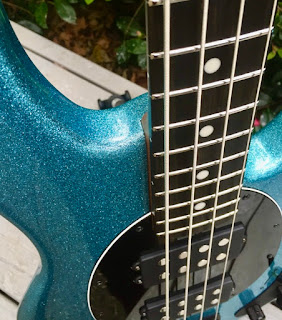 |
| Enjoying the Fireglow! |
At first I gladly accepted the quirks of the Ricky: its antique bridge, wide but shallow neck shape, neck dive, bubbling paint, stubby tuning posts, sharp body edges, and yes-- that large cover over the bridge pickup. On stage it was a struggle to keep the pickup noise at bay and the instruments weight was... weighing on my nerves. But damn, the things look fantastic!
Most of those quirks can be addressed with aftermarket parts, but I didn't really want to spend more money (on two basses) to do so.
 |
| Hello Baaaby! |
The next day I took both Ricks to our local shop and promptly secured my new Aqua Sparkle Stingray Special, which features a very dark ebony fingerboard and black hardware.
Most of us who've sold or traded away instruments have experienced "buyers remorse" of some kind. Meaning, you have a certain level of regret letting go of something which you were once very excited about. This time I don't have any whatsoever. Is it because I'm getting older and understand/ have accepted that tastes change over time? Maybe. Probably, yes.
 |
| The opposite of plug & play, pedalboard ver.2 |
 |
| An air-tight neck pocket |
 |
| A finish with a rich heritage |
Driving an old 1960s Dodge Charger is an experience everyone should have at least once in their lives. It's fun, it's physically demanding and a true joy; much like the Rickenbacker 4003. Living with one as a daily driver however, well that's something else entirely. In the end, I'm thankful to have had the last year with two beautiful Rick basses, but the time has come to pass that joy to someone else, while I enjoy the comfort and luxury of my new, modern bass... It's nice to be home!
...Stay tuned & in tune!













